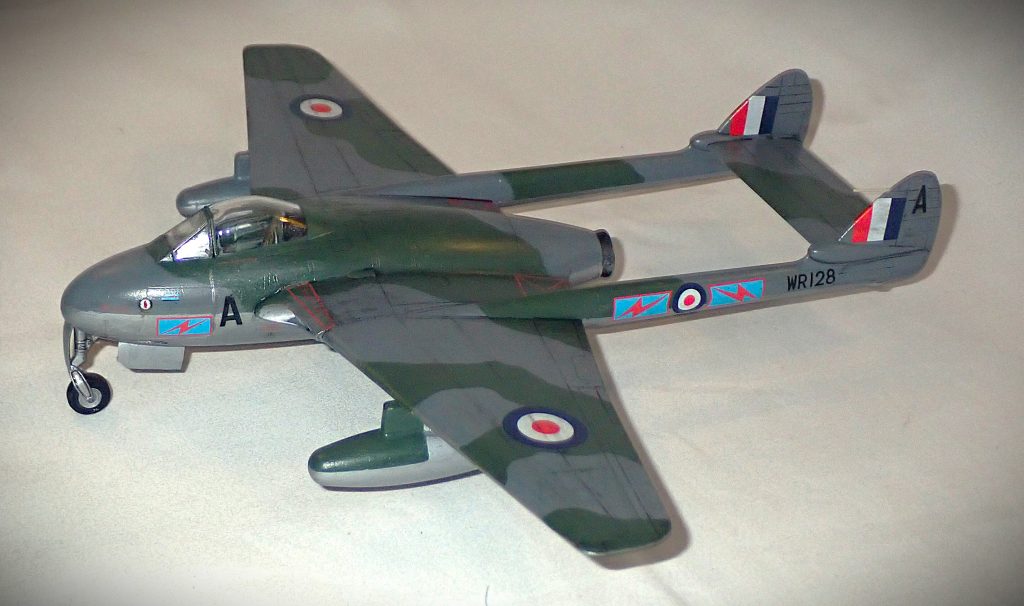The de Havilland DH100 Vampire is a single engine single-seat twin-boom jet fighter developed and manufactured by the de Havilland Aircraft Company. It was the first operational single engine jet and the second to enter service after the Meteor. It was powered by the Halford H.1 Turbojet, later known as the de Havilland Goblin. Frank Halford had been given access to Frank Whittle’s jet powered projects, and he veered off to concentrate on turbojet development.
Designed during WW2, the Vampire first flew in 1943. The RAF ordered 120 Mk.1 Vampires in 1944, but only six were built by war’s end due to setbacks, and production shifted to English Electric. The Vampire did not enter service until early 1946. In total, 3,268 Vampires were built supplying the RAF with its first jet interceptor and being adopted by 31 other Air Forces worldwide.
The Vampire was a simple construction based around the engine which was housed in an egg-shaped fuselage to the rear of the cockpit. The front of the aircraft was formed plywood with stretched metal on the rear, revising the construction methods developed for the Mosquito. All flight surfaces were metal finished. The Vampire was armed with four 20mm Hispano Mk.V cannon in the belly and chin. The Vampire Mk.III was a development which allowed for increased range by installing drop tanks. The modifications to the type included lowering and reshaping of the tail section, modified wings to improve low level performance, increased hardpoints to carry extra stores for ground attack and strengthened undercarriage for the increased weight.
The Vampire FB.5 became the main production version in 1947 with 478 being built, the FB standing for Fighter Bomber. It could carry two 500lb bombs under wing and eight RP-3 rockets on racks. 19 Squadrons were equipped with this variant, mainly in Germany but some squadrons were sent to the Far East for the Malayan Emergency. It was also used by home defence squadrons and reserve squadrons.
A Naval version of the FB.5, the Sea Vampire, was developed for the FAA in 1947 and it became the very first jet fighter to be carrier-borne. In fact, the Sea Vampire holds the distinction of being the first jet aircraft to take off and land on a carrier on HMS Eagle in December 1945 piloted by Henry Winkle Brown. It was also the first RAF fighter to hit over 500mph and the first jet aircraft to cross the Atlantic in 1948 when 6 F.3 Vampires of 54 Squadron flew to Labrador. In 1948 a Vampire Mk.1 set a new height record of 59,446ft (just over 18km).
The Vampire FB.9 became available with the more powerful Goblin III engine in 1952. It replaced some of the ageing FB.5’s. A night fighter version was also produced which replaced the Mosquitos. The ultimate Vampire NF.10 served from 1951 to 1954 with three RAF squadrons.
In the mid fifties the Vampire was being relegated to training and secondary roles as it was being replaced by the far better de Havilland Venom and the Meteor F.8. Most Vampires were phased out by 1959. Training versions of the Vampire were manufactured from 1952 with twin seats and stayed in service as the T.11 eventually being retired in 1963. There were 8 export versions built for various Air Forces around the world, notably Australia who built 80 of the Vampire at the de Havilland Australia factory powered by the Rolls-Royce Nene engine.
There are over 180 Vampires of all variants on display around the world in 30 countries with at least seventeen in airworthy condition. In the UK there are 29 versions, mainly T.11’s in most of the air museums around the country. There are 13 on static display in Australia, one of which is at Queensland Air Museum in Caloundra, just down the road from me.
